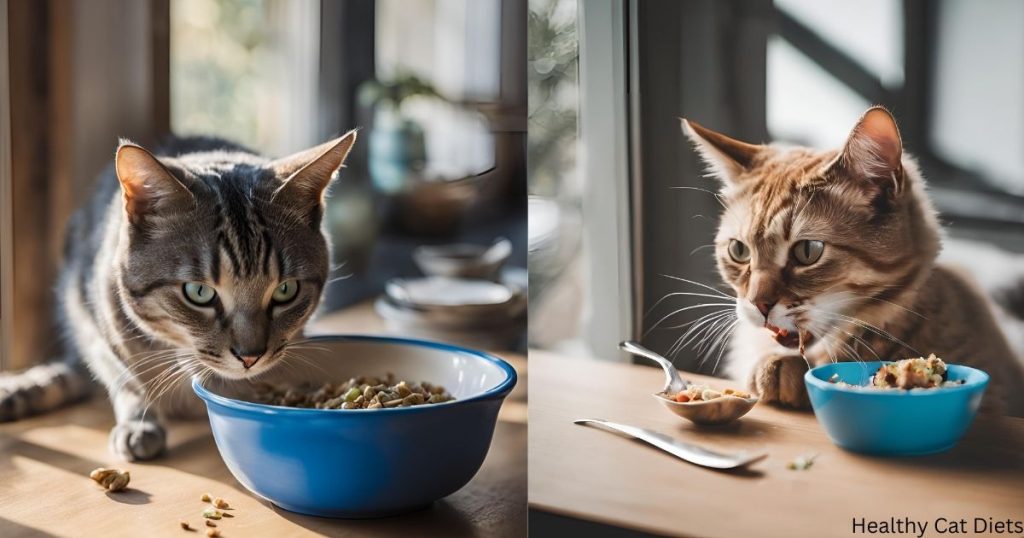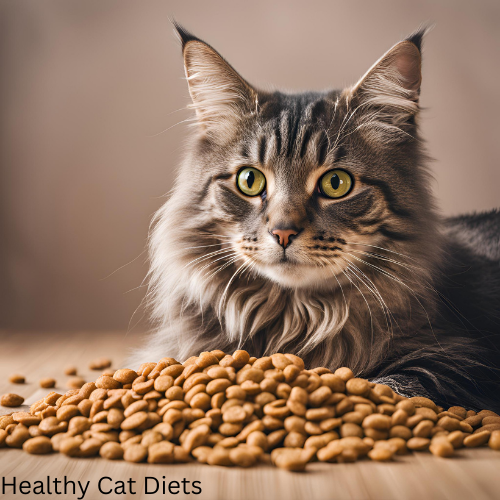Introduction
Why Proper Feeding is Important for Your Cat’s Health
How Much Dry Food to Feed a Cat? Feeding your cat the right amount of food is crucial for their overall health and well-being. Proper nutrition helps maintain a healthy weight, supports organ function, and contributes to a shiny coat and healthy skin. Overfeeding can lead to obesity, while underfeeding can cause malnutrition and a weakened immune system. Understanding how much dry food to give your cat is a key part of ensuring they live a long, healthy life.
Dry cat food offers convenience and can be nutritionally balanced, but it’s important to follow feeding guidelines to avoid health issues. Regularly monitoring your cat’s weight and health can help you adjust portions as needed and prevent problems associated with both overfeeding and underfeeding.
Overview of Dry Food and Its Benefits
Dry cat food, also known as kibble, is a popular choice among cat owners for its ease of storage and feeding. It has a long shelf life and doesn’t require refrigeration, making it practical for busy households. High-quality dry cat food is formulated to provide essential nutrients, including proteins, fats, vitamins, and minerals.
In addition to convenience, dry food helps with dental health by reducing tartar buildup through its crunchy texture. It’s also often more cost-effective than wet food. However, it’s important to choose a brand that meets your cat’s specific nutritional needs and to ensure that dry food is used as part of a balanced diet.
Understanding Dry Food Portions
Is 1 Cup of Dry Food Too Much for a Cat?
The question of whether 1 cup of dry food is too much for a cat depends on various factors, including the cat’s size, age, and activity level. For an average adult cat weighing around 10 pounds, 1 cup of dry food may be an appropriate amount, but this can vary.
Here’s a helpful table showing average portion sizes for different cat breeds and types:
| Cat Type | Weight (lbs) | Daily Dry Food (Cups) |
| Kitten (6 months) | 5-7 | 0.75 – 1.0 |
| Adult Small Breed | 6-8 | 0.5 – 0.75 |
| Adult Medium Breed | 10-12 | 0.75 – 1.0 |
| Adult Large Breed | 14-18 | 1.0 – 1.5 |
| Senior Cat | 8-12 | 0.5 – 0.75 |
Factors Affecting Portion Size: Age, Weight, and Activity Level
Different factors can influence how much dry food your cat should eat. For instance, kittens need more calories for growth, while senior cats may need fewer calories to avoid weight gain. Additionally, active cats require more food compared to sedentary ones. Always adjust the portion size based on these factors and consult with your vet if you’re unsure.
How Do I Calculate Dry Food for My Cat?

Using Weight and Activity Level to Determine Needs
To calculate the appropriate amount of dry food for your cat, start by considering their weight and activity level. Most cat food packaging includes a feeding guide based on the cat’s weight. For example, a 10-pound cat might need ¾ to 1 cup of dry food daily, depending on activity level.
For a more precise calculation:
- Check the calorie content on the food package.
- Determine your cat’s daily caloric needs (consult a vet for this).
- Divide the total daily calories by the calories per cup of food to find the correct portion size.
Example Calculations for Different Cat Sizes and Lifestyles
Here’s an example calculation:
- A 10-pound cat requires about 200-250 calories daily.
- If your dry food provides 300 calories per cup, your cat would need approximately ⅔ to ¾ cup of food daily.
Consulting Your Vet for Personalized Advice
While these calculations provide a good starting point, it’s always best to consult with your veterinarian. They can offer personalized advice based on your cat’s specific health needs, lifestyle, and dietary requirements.
How Many Tablespoons of Dry Food Should a Cat Eat?

Conversion from Cups to Tablespoons
One cup of dry food is approximately 16 tablespoons. To convert your cat’s daily portion from cups to tablespoons, simply multiply the number of cups by 16. For instance, if your cat needs ¾ cup of food daily, that translates to about 12 tablespoons.
Daily Recommendations Based on Cat’s Size and Age
Here’s a quick reference for converting portion sizes:
- Small Cat (6-8 lbs): 0.5 to 0.75 cup or 8 to 12 tablespoons daily
- Medium Cat (10-12 lbs): 0.75 to 1 cup or 12 to 16 tablespoons daily
- Large Cat (14-18 lbs): 1 to 1.5 cups or 16 to 24 tablespoons daily
Measuring Tools and Techniques for Accurate Feeding
Use a standard measuring cup or a dedicated cat food scoop for accurate portioning. Measuring cups ensure consistency and prevent overfeeding. Avoid using kitchen spoons, as they can vary in size and lead to inaccurate portions.
Can Cats Live on Dry Food Only?
Nutritional Balance in Dry Cat Food
High-quality dry cat food is designed to provide complete and balanced nutrition. It contains all the essential nutrients cats need, including proteins, fats, vitamins, and minerals. However, not all dry foods are created equal, so it’s crucial to choose a reputable brand that meets AAFCO (Association of American Feed Control Officials) standards.
Essential Nutrients Provided by Dry Food
Dry food typically includes animal proteins, healthy fats, and fiber. These nutrients support muscle health, energy levels, and digestion. Some dry foods also include added vitamins and minerals to promote overall health and well-being.
Potential Risks of Exclusively Feeding Dry Food
While dry food can meet a cat’s nutritional needs, it lacks moisture compared to wet food. Cats on a dry food-only diet may be at higher risk for urinary tract issues and dehydration. It’s essential to monitor your cat’s water intake and ensure they drink enough fluids.
Importance of Hydration and Alternative Feeding Options
To address hydration concerns, consider offering wet food as part of your cat’s diet or providing a water fountain to encourage drinking. Wet food can complement dry food and help maintain proper hydration levels.
Combining Dry Food with Other Diets
Benefits of Mixing Wet and Dry Food
Combining dry and wet food can offer the best of both worlds. Wet food adds moisture to your cat’s diet, which can help with hydration and urinary health. Mixing wet and dry food can also provide variety and keep mealtime interesting for your cat.
Guidelines for Balanced Diets
When combining foods, ensure that the total daily intake meets your cat’s nutritional needs. Consult with your vet to balance the portions of wet and dry food appropriately. Keep in mind that treats and table scraps should be minimal to avoid disrupting the nutritional balance.
Practical Feeding Tips
Monitoring Your Cat’s Weight and Health
Regularly check your cat’s weight and overall health to ensure they’re receiving the right amount of food. Weight fluctuations can indicate overfeeding or underfeeding. Adjust portions as needed and consult your vet if you notice any significant changes.
Adjusting Portions Based on Weight Changes
If your cat gains or loses weight, it may be necessary to adjust their food portions. For weight loss, reduce the amount of food gradually. For weight gain, increase portions slightly, but ensure it’s done in consultation with your vet to avoid rapid changes.
Signs of Overfeeding or Underfeeding
Signs of overfeeding include obesity, lethargy, and vomiting. Signs of underfeeding include weight loss, lethargy, and a dull coat. If you observe these signs, reassess your cat’s diet and consult with a veterinarian.
You Also Like it:
How Much Food Should I Feed My Cat
How Much Food Should a Cat Eat
Storing and Serving Dry Cat Food

Best Practices for Food Storage
To maintain freshness and prevent spoilage, store dry cat food in an airtight container in a cool, dry place. Avoid keeping food in the original bag, as it can expose the food to air and moisture, reducing its quality.
How to Serve Dry Food to Maintain Freshness
Serve dry food in clean, dry bowls. Avoid letting food sit out for long periods, as it can become stale or attract pests. Refill bowls with fresh food regularly and ensure your cat always has access to clean water.
Conclusion
Summary of Key Points
Feeding your cat the right amount of dry food is essential for their health. Consider factors such as weight, age, and activity level when determining portions. Combine dry food with wet food if needed to ensure proper hydration and nutrition.
Final Tips for Feeding Your Cat
Monitor your cat’s weight and health regularly, adjust portions as necessary, and always choose high-quality food. Consult your vet for personalized advice and make feeding time a positive experience for your furry friend.